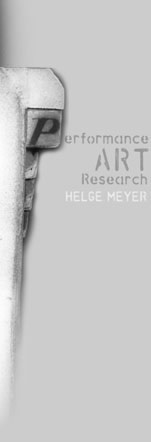April 10, 2005
Helge Meyer “Hand to Hand” @ PSi #11 - By Erik FabianHelge Meyer presented his ongoing, clothing exchange performance “Hand to Hand” at PSi #11 at Brown University. It consists of the simple structure of offering each item of clothing he is wearing to an audience member in exchange for an item of clothing. Helge requests a story about each piece of clothing that he receives and then tells that story when he again trades the piece of clothing away in the next performance. After several performances of this piece Helge has no pants, socks or shoes, but is wearing multiple pieces of jewelry, a white shawl wrapped around his waist and three layers of women’s underwear. After the exchange of clothing and stories, Helge takes a shot of alcohol (whatever the locals drink) with the brave audience member and so spends the performance getting drunker and drunker in addition to sealing the deal via German custom.
Simply put I think this piece just works and not much need to talk about it. Maybe I am an easy convert but for the sake of sharing the experience, I will yap about it for a few paragraphs.
Like much post-modern performance, it illustrates networks of social interactions and exposes some culture idiosyncrasies. It has no clear ending at this point and conducts a kind of casual cultural research. Sentimental value is held higher than the utility or financial value of the clothing and the piece is a collaboration with the audience, facilitated by Helge, more than an expression of a modernist perfection in presentation.
My experience was mostly about deciding if I would trade or not, feeling the pressure in the small audience not to let the performance fail, thinking about the potential loss of my clothes, whether I was willing to drink the alcohol (I don’t usually drink), and the possible public nakedness and hygiene risks of participating. I ultimately decided not to trade (and then later traded a plastic bag into his system for a bit of video tape time) but most of the audience did in this small crowd. Helge says in the past his crowds have been huge and fighting for the chance to exchange their clothes so this performance not only seemed to challenge him with the potential of failure for the first time but also perhaps heightened the creation of cliques of participants and non-participants in the room. By the end, Helge and the traders in the audience were finishing off the bottle of raspberry vodka while the Q&A went on.
During the beginning, one woman stood up and announced she was leaving because she felt she would not trade and did not want to be a voyeur. Helge was unable in this case to convince the woman it was ok to stay, but was efficiently soothing presence throughout the performance in general. He opening the piece by first mildly putting himself at risk by entering in a suit, silently stripping naked, dowsing himself in rubbing alcohol and then putting on each of the items of clothing to share. Once in the clothes he started talking, explaining the rules of the game and, along with the alcohol, he claimed everything was freshly laundered to soothe hygiene concerns.
This silent opening also served as a bit of ritualistic transition the outside world to a private world, from a more modernist aesthetic to the more post-modern one. The alcohol rubdown was particularly striking as a smell as well as alchemical substance…I felt like I could see/feel the evaporation happening and it had an interesting effect of muting the novelty of his nudity.
After the fact I think the most interesting thing about this piece is the position Helge places himself in as salesman. While perhaps in the past, the proposition of exchanging clothes, has been an easy sell for Helge, sales-minded is what he is and in a way a bit evangelical. Helge presents himself in with a very gentle, welcoming demeanor. He invites you participation and asks for your help. The seduction is the potential of membership in this performance and its history. You are offered a moment in the spotlight and almost Homeric value system of heroic action and eternal life through stories. It is up to Helge as the salesman not only to keep the piece going but also to draw out good stories and a sense of community from the room. It is perhaps the birth of a new secular religion.
Helge also seems to be easily holding up material value of the pieces right now with his sincerity, stories and perhaps the locations of presentation.
I suppose there is kind of implied exhaustion to this piece right now. I wonder how long this will remain interesting to exchange clothes with ready and willing artists at art festivals and conferences and if it is sufficient for Helge to link these groups and to ride out the life of this piece just casually comparing cultures. It all get a bit more dangerous to me if presented in a jail where the hygiene issue is even more significant, in a truly impoverished place, or if he were to receive clothes or jewelry of significant financial value sometime.
“Hand to Hand” brought a nice feeling to conference and created some community, which was welcome. One thing I learned from talking to Helge was how performance artists use festivals and conferences as major venues for their work in Europe and Helge is mapping that world. He also walks his talk, as some say in America, which is nice to see as well.
And the Helge clothes story continues.
